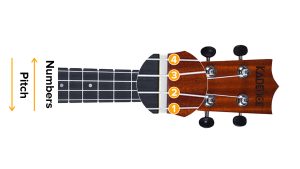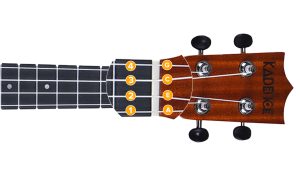So, you got yourself a new ukulele and now you are wondering if the strings on your ukulele have names?
Well, they do, and the faster you familiarize yourself with these names, the easier it will be for you to tune and learn the Ukulele. This is because you are going to find these ukulele string names everywhere – starting from blog tutorials to YouTube videos.
In this article, we will cover everything about the string names, numbers, and notes for all types of ukuleles.
The ukulele string names for the first 3 types- soprano, concert, and tenor ukuleles are similar (since they are tuned to the same notes) and the string name for the Baritone ukulele is different because of its unique tuning.
But let’s first understand,
The numbering of ukulele strings
All string instruments, not just ukuleles, are numbered in a similar fashion and it starts with assigning the highest pitched string the lowest number, i.e., 1 and the numbers go up as the pitch goes down.
Here’s how:
 Thus, while you hold your ukulele, the string farthest from you (bottom-most) has the highest pitch and is numbered 1, while the string closest to you (top-most), has the lowest pitch and is numbered 4.
Thus, while you hold your ukulele, the string farthest from you (bottom-most) has the highest pitch and is numbered 1, while the string closest to you (top-most), has the lowest pitch and is numbered 4.
Another way to remember the relationship between a string’s pitch and their numbering is by keeping in mind that ladies have a higher pitched voice and they come first (“Ladies first”) :p
Now, back to the string names…
Ukulele string name for Soprano, Concert and Tenor Ukuleles
These are the most popular ukuleles and chances are you have one of these.
And the string names for these most commonly found ukuleles – soprano, concert and tenor are:
G-C-E-A. This is known as the standard ukulele tuning.
Here is a picture for your reference,

As you can see, the names of the strings starting from what is closest to you to what is farthest from you are G, C, E and A. Remember to reverse the order if you are a left-handed uke player.
We also have a mnemonic device you can use to remember this string name sequence, and it goes like, “Guys-Came-Entered-Ate”. Simple, right?
Now, let’s move on to,
The ukulele string name for the Baritone ukulele
As mentioned above, the baritone uke has a different tuning than the other 3 types of ukuleles and it is tuned to D-G-B-E, which is similar to that of the top 4 guitar strings. Which makes sense given that the baritone is much bigger than the other ukes and almost as big as a small guitar.
Here is a picture for reference,

As you can see, the names of the strings starting from what is closest to you to what is farthest from you are D, G, B and E. Again, don’t forget to reverse the order if you are a left-handed uke player.
A mnemonic device you may use to remember this sequence is: “Dogs Go Back Eating” because, let’s be real, dogs do love eating (a lot)!
Relation between ukulele string names and string numbers
It is important to note that the sequence of the string names is listed in reverse order of the string numbers, i.e., for the standard ukulele tuning G-C-E-A, string 4 is tuned to G, string 3 to C, string 2 to E and string 1 to A.
In other words, string notes G-C-E-A correspond to string numbers 4-3-2-1.
Still confused? Don’t worry, I’ll make it simpler,
Remember the “Guys-Came-Entered-Ate” mnemonic device for ukulele string names? Let’s add ukulele string numbers to it and modify it a little:
“(There were) 4 Guys-3 Came-2 Entered-(and) 1 Ate”
Now this is all you should need to never forget the name as well as the order of numbering of the ukulele strings.

Now you might be wondering,
Are string names and string notes the same thing?
Well, the difference between “ukulele string names” and “ukulele string notes” comes down to terminology than anything else.
Both terms refer to the notes that the strings play when open(i.e., when they are not fretted), but “string names” emphasizes the identity of each string, while “string notes” emphasizes the sound that each string produces.
For example, in the standard ukulele tuning G-C-E-A, the string plays the G note, the C string plays the C note and so on.
Why are string numbers preferred to string notes?
Let me preface this answer by saying that not everyone prefers to use string numbers to names and it is recommended for beginner ukulele players to get accustomed to both styles.
There are, however, two obvious answers as to why string numbers is a more commonly favored method of referring to ukulele strings,
a) Use of different ukulele tunings
Not all ukulele players are the same and some of them might tune their ukuleles in a manner that is different from the standard G-C-E-A tuning, thus, using string names might lead to a confusion when communicating with such players.
For instance, A-D-F#-B is a popular way to tune soprano ukuleles to get that brighter, authentic ukulele sound.
b) String notes can differ when playing chords
Referring to an individual string using a string note can cause confusion as they change while playing chords.
For instance, when you play a G major chord, the notes you play are G, B, and D.
Now, if your teacher tells you that your D note doesn’t sound right, it might be confusing. This is because in a G major chord, there can be two strings playing the D note.
So, it’s unclear which D note your teacher is referring to. To avoid this confusion, it’s easier to use string numbers instead of note names.
For example, instead of saying “your D note is off”, your teacher could just say “the note on your 3rd string is off”. This way, you know exactly which string needs adjustment, no matter what note it’s playing. This method makes learning to play the ukulele much simpler and more precise.
Closing thoughts
Congrats! You’ve now conquered ukulele string names, numbers, and notes!
And here are the key takeaways for you:
- a) Standard tuning (soprano, concert, tenor) – GCEA (strings numbered 4-3-2-1)
- b) Baritone ukulele – DGBE (strings numbered 4-3-2-1)
- c) Get used to both names and numbers to become a well-rounded ukulele player!
Now get out there and strum away!


My brother suggested I might like this website He was totally right This post actually made my day You cannt imagine just how much time I had spent for this information Thanks
I was recommended this website by my cousin I am not sure whether this post is written by him as nobody else know such detailed about my difficulty You are wonderful Thanks